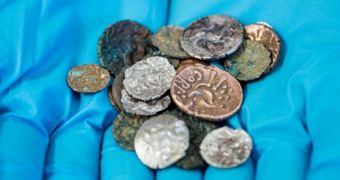Archaeologists in the United Kingdom have recently announced the discovery of a total of 26 coins estimated to be thousands of years old in Dovedale, a valley located in England's Peak District.
Interestingly enough, it looks like these coins were discovered quite by chance. Thus, nobody was purposely looking for them at the time they were found.
On the contrary, historians were pretty much oblivious to the fact that something in Dovedale was well worth digging for and only found the coins thanks to a tourist exploring the region.
According to Daily Mail, it was a hiker with no training as an archaeologist who first came across 4 of the coins while walking about a cave in Dovedale. Shortly after, historians arrived in the area and found the other 22.
Information shared with the public says that, of the 26 coins that have until now been recovered at this archaeological site, 20 date back to the Late Iron Age and were likely forged by members of a local tribe known as Corieltauvi.
It is believed that, contrary to how money works in this day and age, members of the Corieltauvi tribe did not use these coins to buy things that they needed. They instead used them to hint at their power and status in the community.
“The coins would suggest a serious amount of wealth and power of the individual who owned them,” archaeologist Rachel Hall with the country's National Trust for Places of Historic Interest or National Beauty explained in a statement.
The other coins discovered in this cave in England's Peak District are said to be of Roman origin. Much like the Late Iron Age coins, they are believed to have laid undisturbed for over 2,000 years before being discovered.
For the time being, archaeologists and historians are yet to figure out how and why these coins ended up in the same cave together. More so seeing how this is the first time when Roman and Corieltauvi coins have ever been found buried in the same place.
To add to the mystery, Rachel Hall and fellow researchers don't quite know why it was that the coins were found in a cave and not out in the open. “The situation of the cave can’t be ignored either,” the archaeologist commented on this discovery.
“Could it have been a sacred place to the Late Iron Age peoples that was taboo to enter in everyday life, making it a safe place that would ensure that person’s valuables were protected?” the National Trust for Places of Historic Interest or National Beauty archaeologist added.
After being dug out, the coins were handed over to specialists at the British Museum and University College London. They are expected to go on display at the Buxton Museum later this year.

 14 DAY TRIAL //
14 DAY TRIAL //